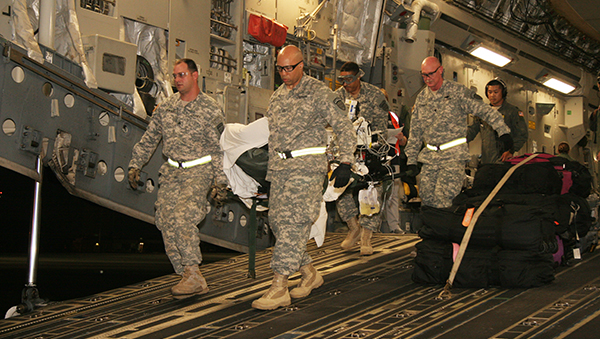
Dialysis. A life-saving medical treatment for millions of people in the United States who suffer from kidney disease or renal failure. Without it, the life of a person is measured not in years, months, or even weeks, but in days. In Puerto Rico and the U.S. Virgin Islands (USVI), approximately 6,200 people rely on treatment two to three times per week through more than 51 dialysis facilities. This hurricane season, the U.S. Department of Health and Human Services (HHS) and its partners undertook an unprecedented effort to save lives and help this very vulnerable population (and the centers they rely on) manage as their island territories recover.
When Hurricane Irma hit USVI in early September, both dialysis centers on St. Thomas suffered severe damage. Working together, personnel from several HHS agencies, the Department of Defense (DoD) and the Department of Veterans Affairs evacuated approximately 100 dialysis patients and their caregivers from St. Thomas to Puerto Rico.
Less than two weeks later, Hurricane Maria hit USVI and Puerto Rico, bringing mind-boggling destruction. One of the two St. Croix dialysis centers was destroyed and the two on St. Thomas remained closed, further limiting the number of patients who could be treated. In Puerto Rico, dialysis centers suffered varying degrees of damage; those remaining open began operating on generator power.
What happened to those dialysis patients who evacuated from St. Thomas to Puerto Rico? Before Hurricane Maria made landfall, HHS and its partners relocated those patients to Miami, Florida, where HHS personnel were staffing a medical shelter. When this shelter closed, the patients were relocated to Atlanta, Georgia. This work also included coordinating services with other federal agencies and non-governmental community organizations to help patients register with FEMA’s individual assistance program and to provide patients hotel accommodations, transportation to and from dialysis, emergency financial assistance, food specified for renal diets, and medications.
In addition, with the damage Maria caused in USVI, HHS, VA, and DoD worked together to evacuate all dialysis patients who wanted to go from St. Croix to Atlanta.

One week prior to Maria hitting Puerto Rico, the Centers for Medicare and Medicaid Services (CMS) worked with the Kidney Community Emergency Response (KCER) center and major dialysis providers to reach out to the 6,065 dialysis patients in Puerto Rico. The centers had coordinated “pre-dialyzation,” an emergency measure that ensures all patients, outside their normal treatment schedule, received shortened length of dialysis right before the storm. Pre-dialyzation helped ensure all patients could go without treatment for a few days immediately following the hurricane.
HHS agencies worked with KCER and the dialysis facilities to track the status of Puerto Rico’s dialysis patients to ensure they had access to care after Hurricane Maria hit the island. The facilities heard from 99 percent of the 6,065 patients that they were alright and receiving treatment. Most of the remaining one percent had left Puerto Rico prior to the storms.
Immediately after Maria hit, the government of Puerto Rico instituted a curfew so dialysis facilities had a shorter amount of time each to provide treatment. The island’s dialysis facilities ran short on treatment supplies, clean water and generator fuel. The end result: some facilities could provide only shortened treatments in order to provide at least some dialysis to everyone.
In a moment of crisis, HHS worked with the Department of State and the British Ministry of Health to transfer treatment supplies from a dialysis facility in the British Virgin Islands to a Puerto Rico facility to keep the facility open.
To benefit all dialysis facilities, HHS agencies worked with FEMA and other agencies and the private sector to ensure that dialysis centers and hospitals received priority for deliveries of water, supplies, and fuel. As high priority facilities, their supplies are offloaded immediately from incoming ships, and HHS arranged for law enforcement officers to travel with truck drivers to ensure delivery trucks reached their destinations. When needed, HHS staff members pushed to prioritize the delivery of replacement generators to help dialysis centers remain operational.
Interagency partners have worked together continuously to make sure that dialysis patients could continue to receive care despite the damage to facilities and loss of power across the island. Thirty days after the two massive storms, all but two dialysis centers were open and providing full dialysis treatments.
HHS is helping the facility staff members, too. In collaboration with the Puerto Rico Department of Health and other federal and private partners, HHS is working to develop and implement a process for credentialing nurses and technicians from the mainland to relieve dialysis facility staff as necessary and make sure that this workforce has the supplies they need to get to and from work each day.
As an a longer-term measure, HHS, DoD, and the Army Corps of Engineers are coordinating the implementation of temporary hospitals in the U.S. Virgin Islands while the local hospitals are rebuilt. CMS is providing consultation on dialysis medical needs and equipment to ensure that these resources are available in both the temporary and rebuilt hospitals.
Saving the lives of dialysis patients takes planning, partnerships and coordination. If you or someone you love relies on dialysis, learn about alternative treatment centers in your area in case of a disaster and find out what you can do before, during and after a disaster to stay healthy. If you operate or coordinate with a dialysis center, learn about best practices for keeping your patients safe when disaster strikes.

